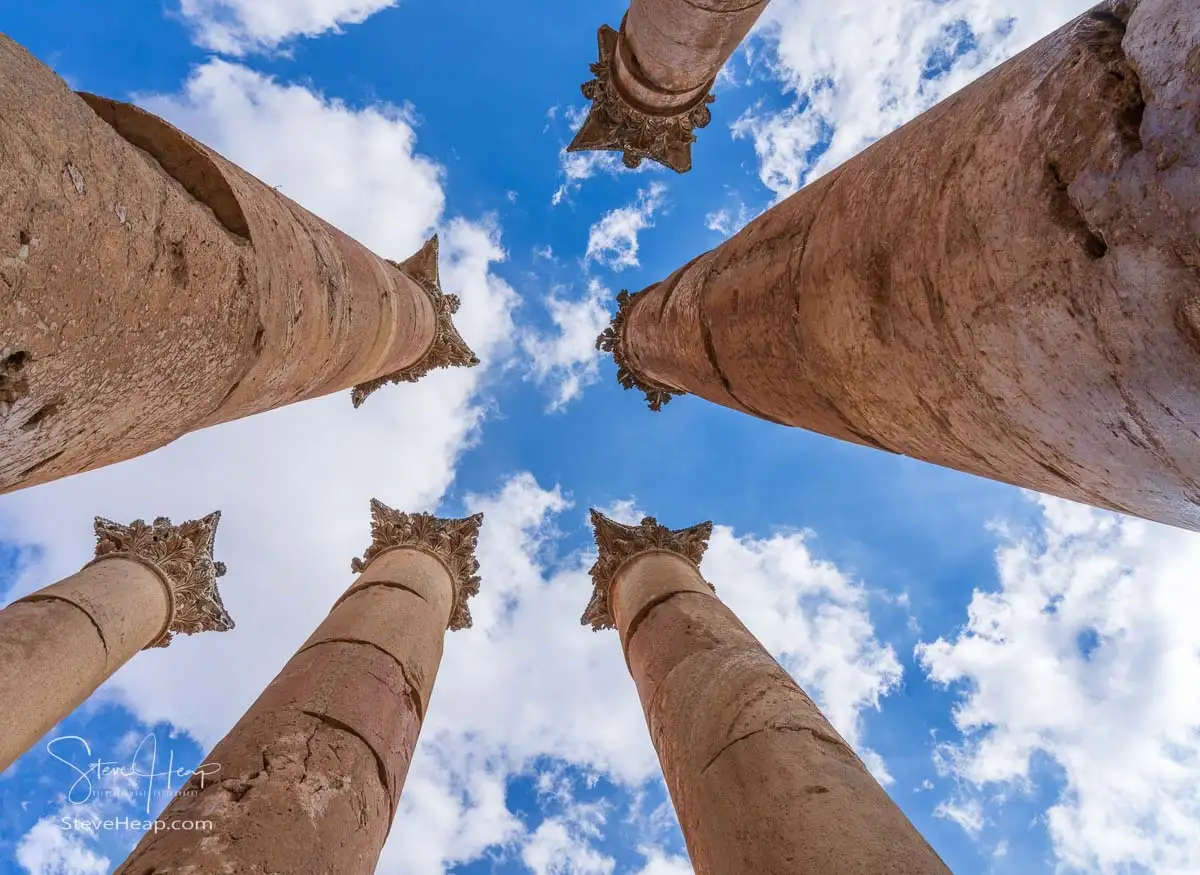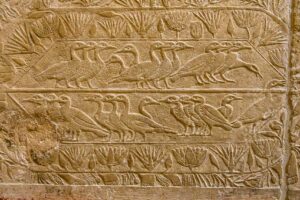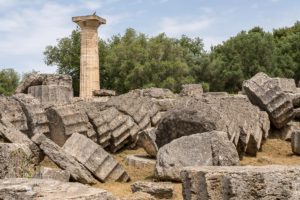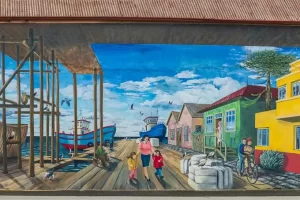After the excitement and perhaps weariness of Petra, we boarded the coach to drive north back past Amman and on to the Roman city of Jerash. This is the next chapter of the extended review of the Jordan extension that Viking offers with their Pharaohs and Pyramids Nile cruise.
We did break the coach journey at a store that demonstrated how stone mosaic pictures were made – very impressive pieces of artwork and a couple of people from our group bought one to be shipped home. Another free toilet as well!
We probably arrived at Jerash just after noon, but our guide suggested that we visit Jerash first and then have lunch later in the afternoon, which was probably a good idea, and so we drove up to the obligatory shopping market that led to the entrance to Jerash. And what a surprise it turned out to be. Like most of our group, I had never really heard of Jerash and so it was difficult to know what to expect, but what we found was a fantastically preserved and restored Greco-Roman city with an entrance monumental gateway that set the scene for what was to come:
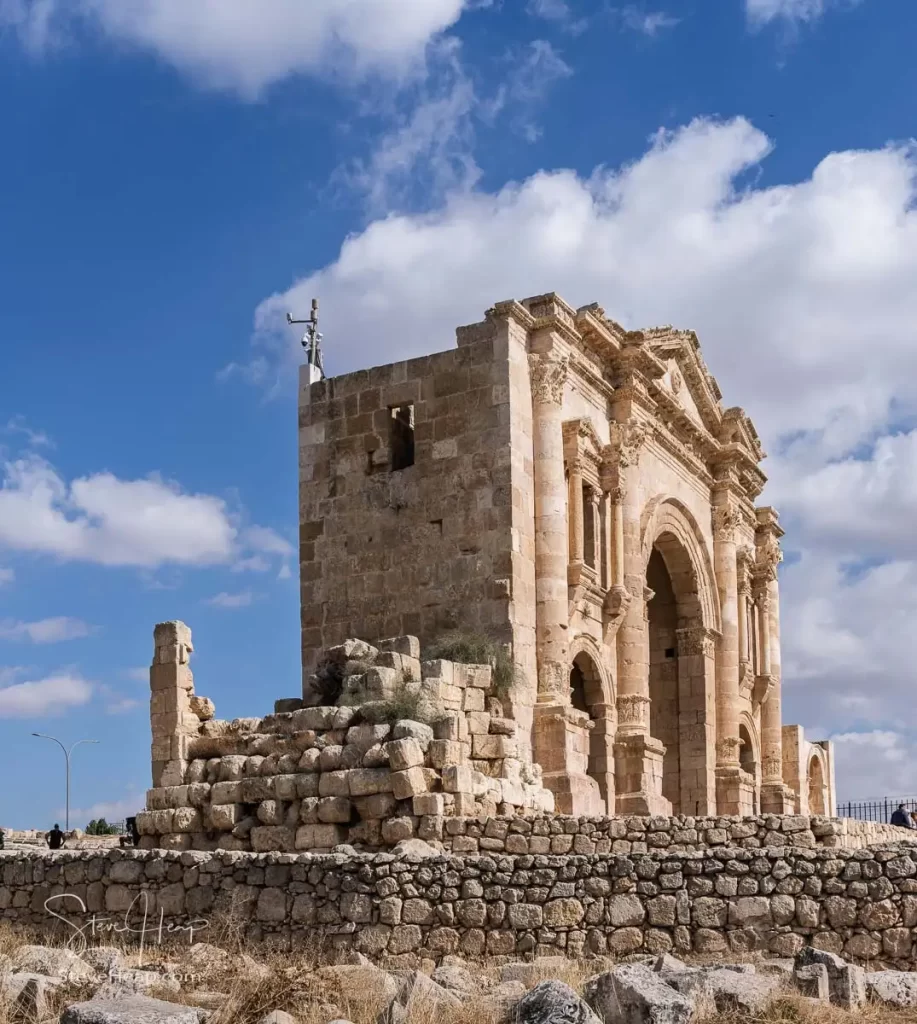
You can’t really see anything of the scale of this city when you approach the gateway, but we soon got a good idea of what was to come. After a longish (but flat) walk, we reached the entrance gate to the city itself with the ticket office.

We walked further into the restored city and came across the largest plaza that has been discovered to date. Known as the Oval Plaza, it is also the only oval shaped area and it still has the original flooring that the Romans constructed almost 2000 years ago.
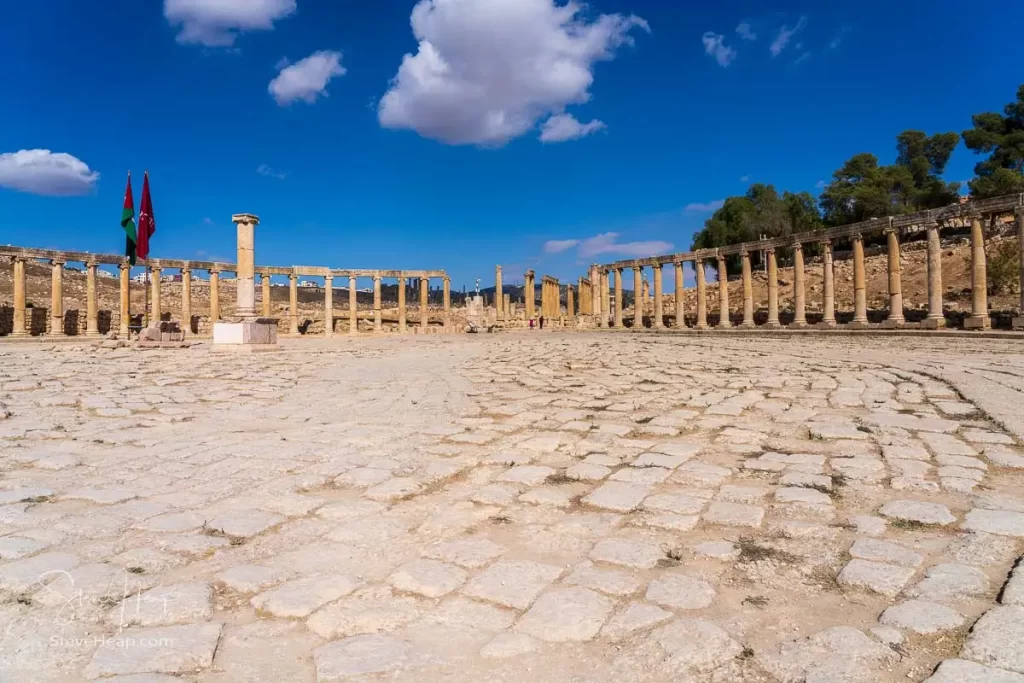
This looks impressive on its own, but it is actually just a part of this massive plaza that was constructed as a junction between the main streets of the city. Here is the full view in a panoramic format:

How did all this come about? The Greeks had built a city here known as Gerasa, or Antioch on the Golden River. This was around the spring of 331BC. Then in the early 80s BC, the Judean kingdom took over the city and there are findings that many public buildings were destroyed around this time. However, this was short lived and in 63BC, the Romans took over the area and started its revival. By the second half of the 1st Century AD, the city had achieved great prosperity and it was part of the Roman province of Arabia along with Philadelphia (not that one, but is actually modern Amman), Petra and Bostra. Roads were constructed and the Hadrian’s Arch we first saw was bult around AD130.
Not to last, of course. The Muslim forces took over the area in 636AD and it continued under their rule until a devastating earthquake in 749 destroyed much of Jerash and the surrounding area. Small villages and settlements continued in the area over the centuries but in 1838, Jerash was described simply as a ruin. In the 1920s, excavations started, and the true nature of the city was finally discovered in the modern age. Much has been re-constructed from the ruins and many mounds of fallen stones still dot the landscape, but it is now described as the best-preserved city of the Roman era outside of Italy.
To simply say this is an expansive site rather undersells its size. At the edge of this Oval Plaza is the main street of the city, Cardo Maximus. Pretty long, and that building you see in the center of the street is not the end, it is a building that marks the junction with one of the major side streets:
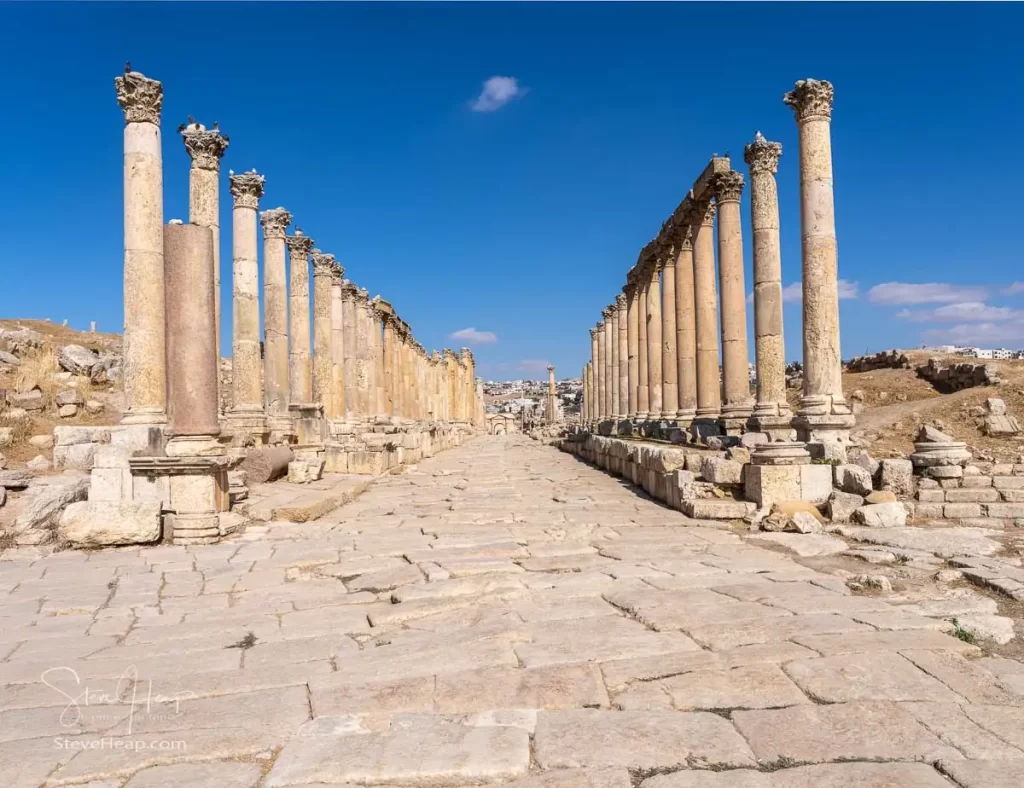
As we strolled down this street standing on the stones that the Romans had laid, our guide found one that could be moved – there is actually an underground waterway under the road to take away rain and other liquids so that the road surface remains clean. Part way along we first visited the Agora or marketplace and then came across this very impressive Nymphaeum or public fountain that you can really imagine as it was in Roman days:
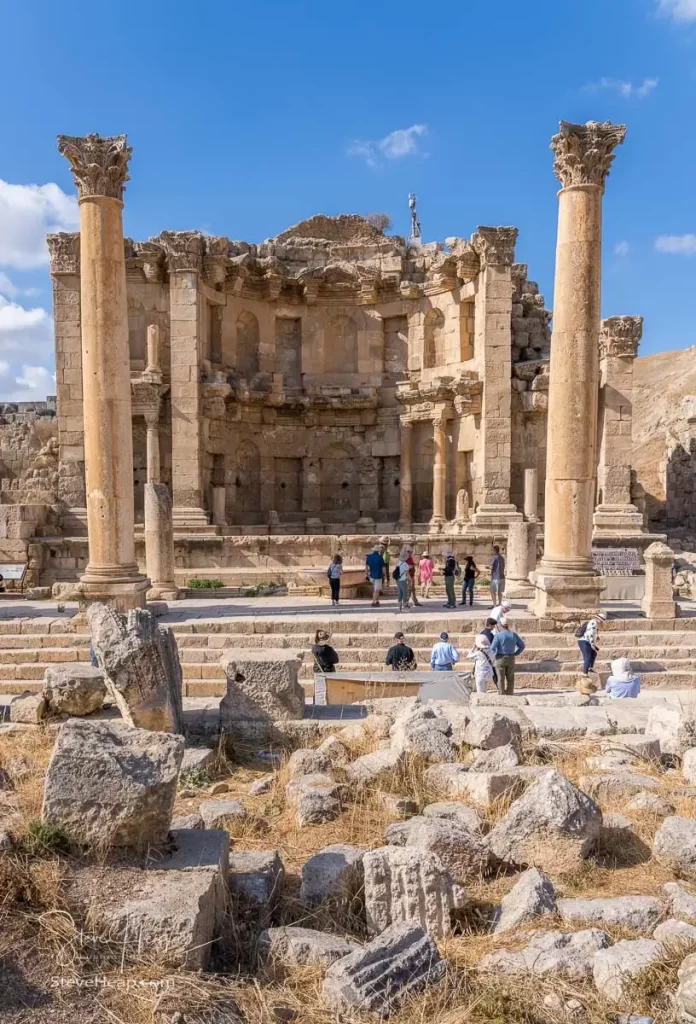
You can see, in this photo, what the site must have been like with broken stones littering the ground after the earthquake.
Further along Cardo Maximus, we came across this massive, monumental staircase that was constructed as the main approach to the Sanctuary of Artemis. there was a large altar terrace and archway halfway up the staircase in those days.
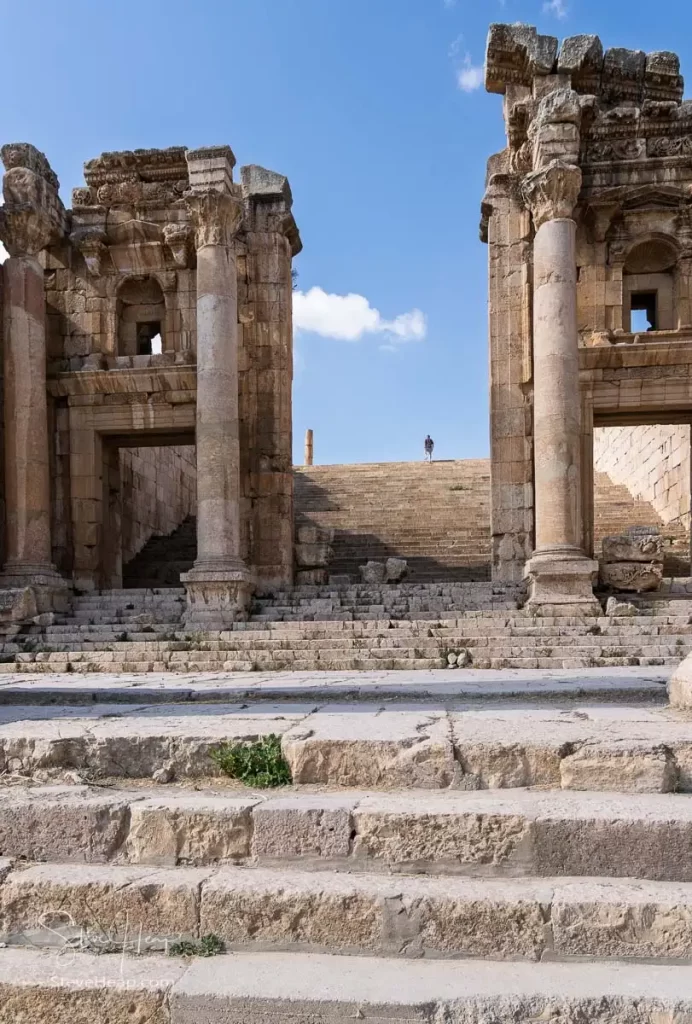
Finally, as we approached the North Gate, we took a right along North Decumanus street towards the theater. Just one of two in this massive city! This one, the North Theater, could handle up to 4000 people, but would normally be used for smaller scale gatherings:
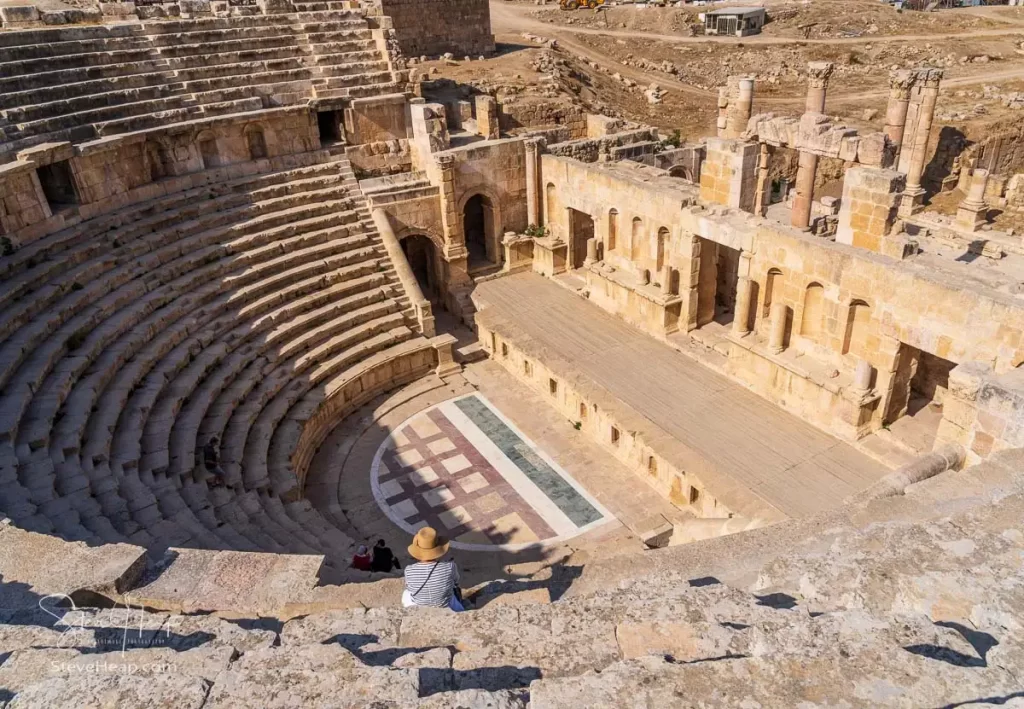
The acoustics from the stage and the orchestra pit were very impressive – some in our group had pretty good singing voices!
Leaving that theater behind, we headed out again, this time to the Sanctuary of Artemis with its Corinthian columns. As you can see from these images, there were few visitors besides our group, although each major monument had a couple of local people either wanting to help with photographs or sell a small range of souvenirs. Nothing like the pressure in Egypt, though.
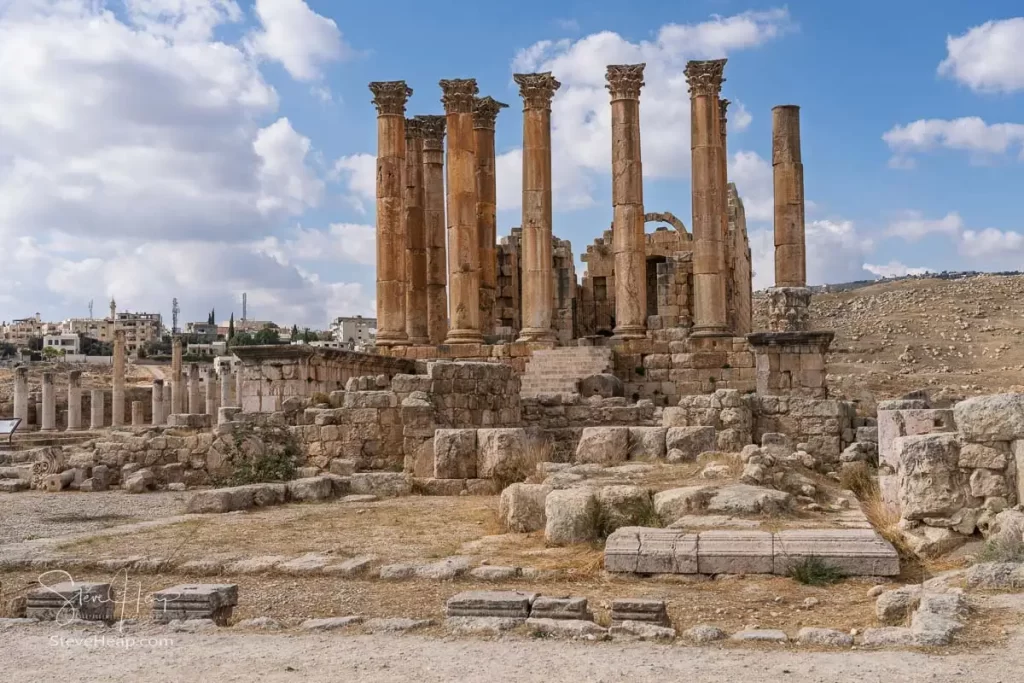
One of the columns is slightly wobbly and can be moved with a little push (although I’m not sure that this counts as a little push!)
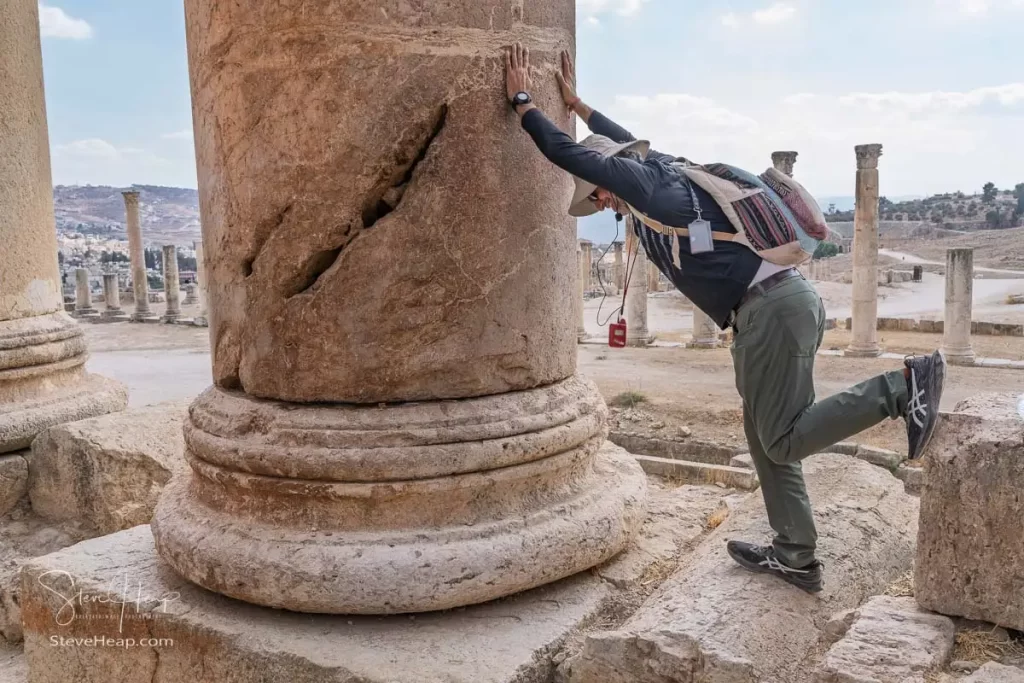
This is not actually a flaw in construction – they were designed to be slightly flexible to withstand earth tremors and are actually made from stacked drums of stone that get narrower as they go to the top, and they have been placed on a large iron dowel that runs through the center of the column to keep them all aligned. Apparently, they can move with breezes blowing across the site and, if you look closely, you can see small metal objects that have been flattened as the column moves back and forwards.

You can get a great abstract image here as well, by looking up at the sky from the base of the columns:
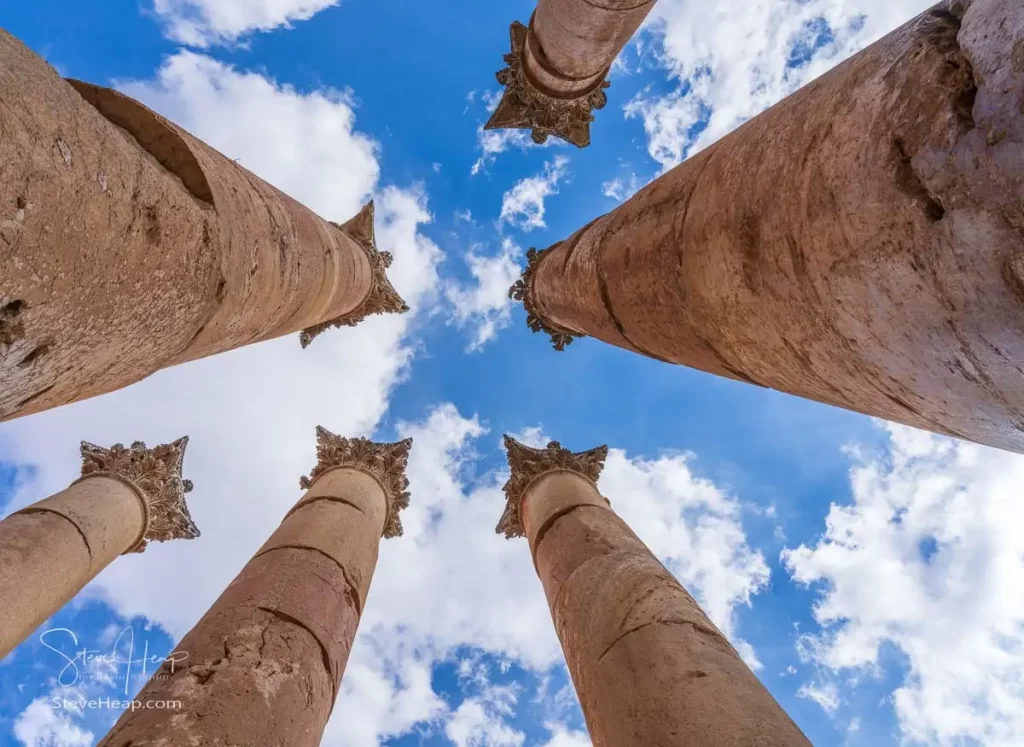
Close by is a magnificent mosaic floor in one of the three churches on the site. This one is the Church of SS Cosmas and Damian. This can only be viewed from above – the other churches can be explored on the ground.
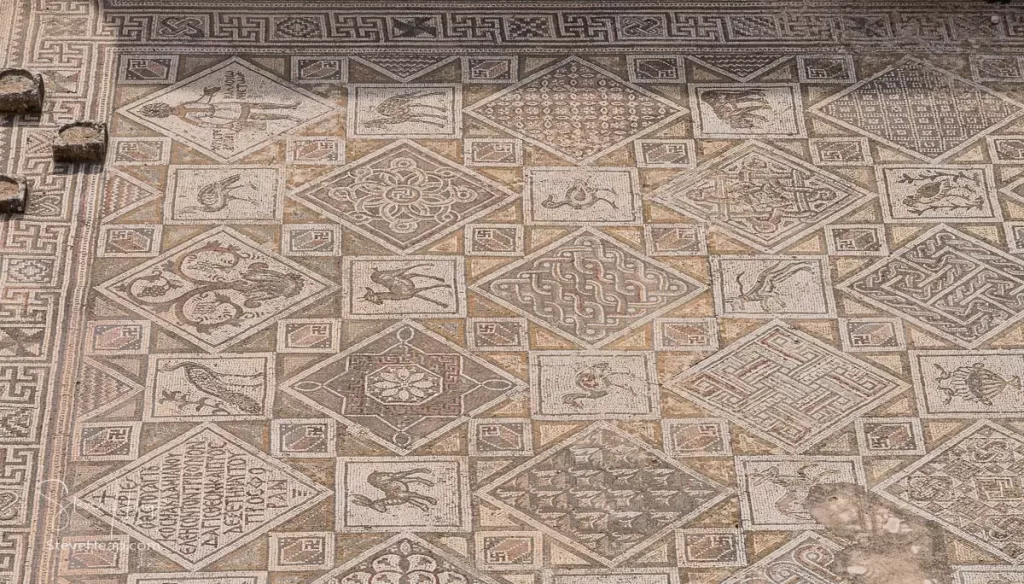
You can probably realize that we were getting slightly weary by now and our group tended to spread out as we walked from monument to monument. The modern city of Jerash can be seen in the distance on the hills surrounding the old town.
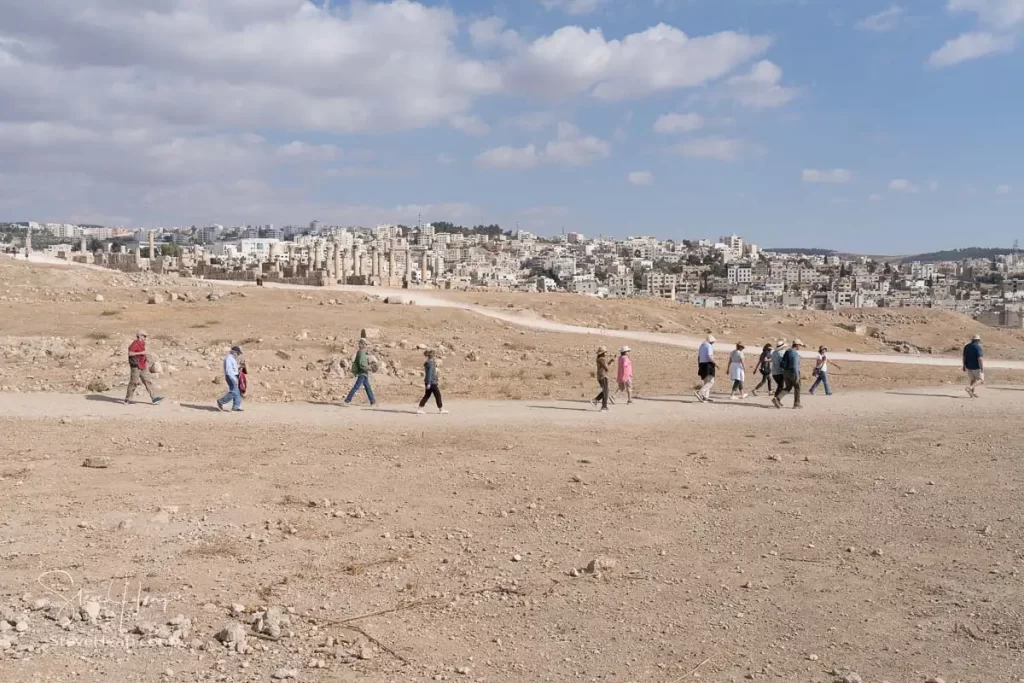
We next made our way to the largest theater on the site – the South Theater. This one was remarkably well preserved, although local residents had been reusing the stones in their own homes until the 1950s. It has been reconstructed and is used in festivals in the city these days. It was inaugurated in 90AD although building works continued after that date and the huge array of seats could hold about 4700 people.
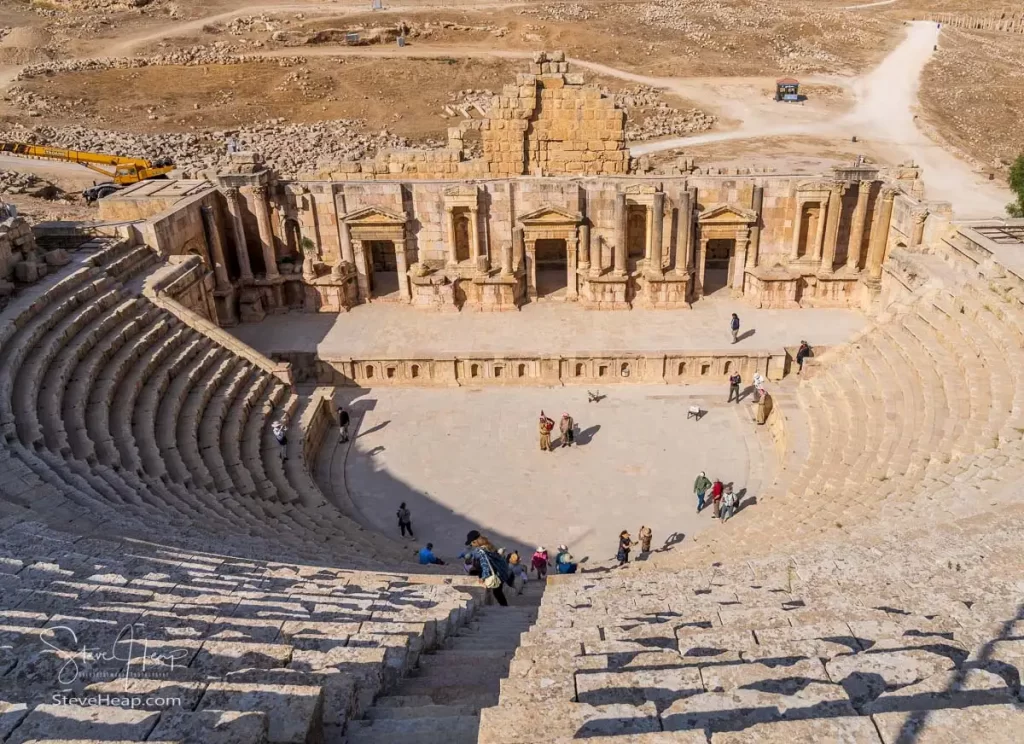
The detail in the stage and backdrop look exquisite, but it does make you wonder if they held farces where actors would disappear through one door and then pop up elsewhere?
From the orchestra area, the seats can appear even more steep and dramatic. No railings here to stop you falling from top to bottom!
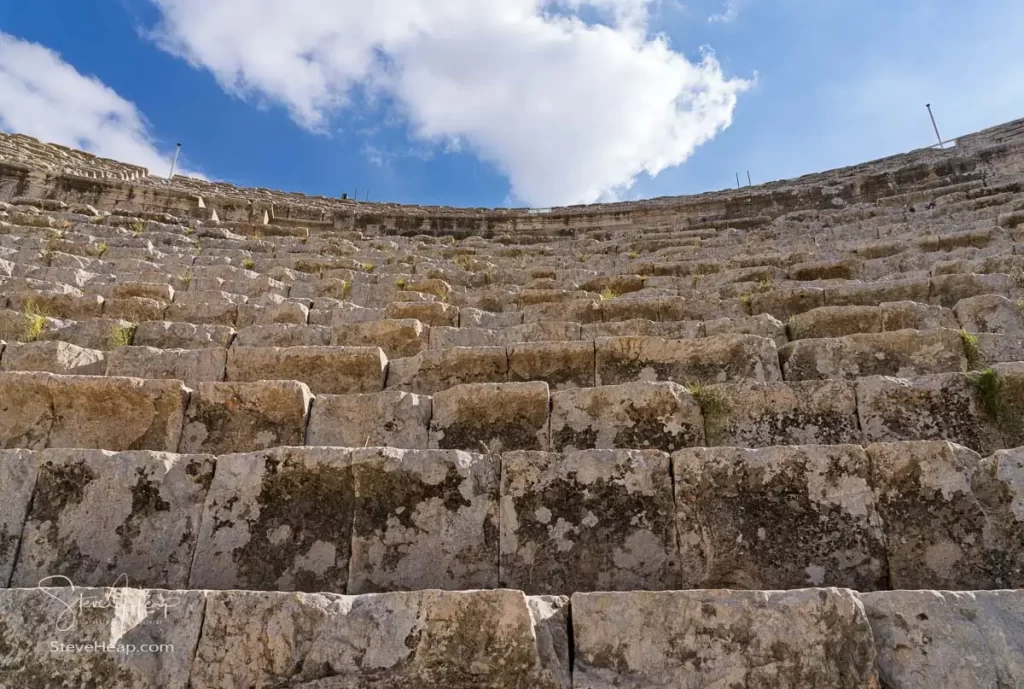
With that, our weary group made its way back through the ticket entrance to Hadrian’s arch, braved the local shops and made it back to the coach. After the miles in Petra the day before, this should have been easy, but I must admit that the line of people was getting pretty extended as we finally got back.
As promised, we headed to the local restaurant for a great lunch/midafternoon meal before boarding the coach one more for the final leg of the journey to Amman.
Unfortunately, rush hour in Amman is no different to the traffic in most major cities and so we finally got to the Fairmont hotel in the Northwest of the city around 5:30pm. The Fairmont is a great hotel, but we were staying for 2 more days in Amman because our chosen flight with United via Dubai only operates every two days. So, we had booked into the Amman Hilton for those 2 nights – another very luxurious hotel that looked after us very well.
This was the final goodbye for the group after spending many days together over the past two weeks. We tipped our guide ($100 if I recall). It is very clear that the downturn in tourism has hit guides very hard and our guide mentioned that he only had this one tour that month. Very different to the previous years.
I’ll complete this extended story with one final article – our two days in Amman.
